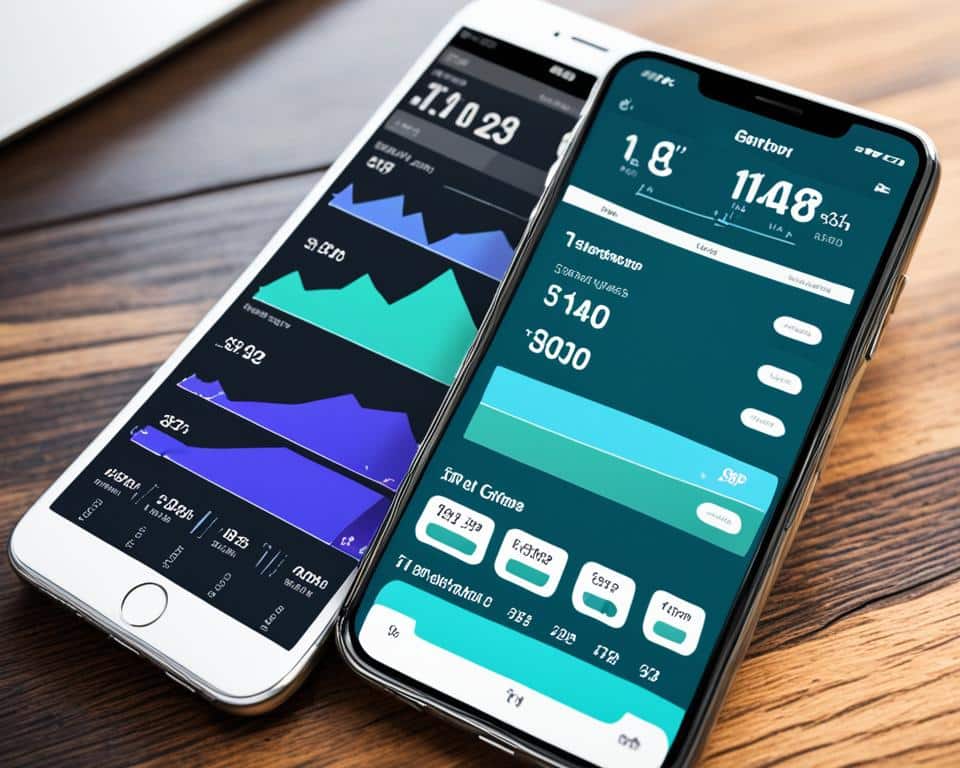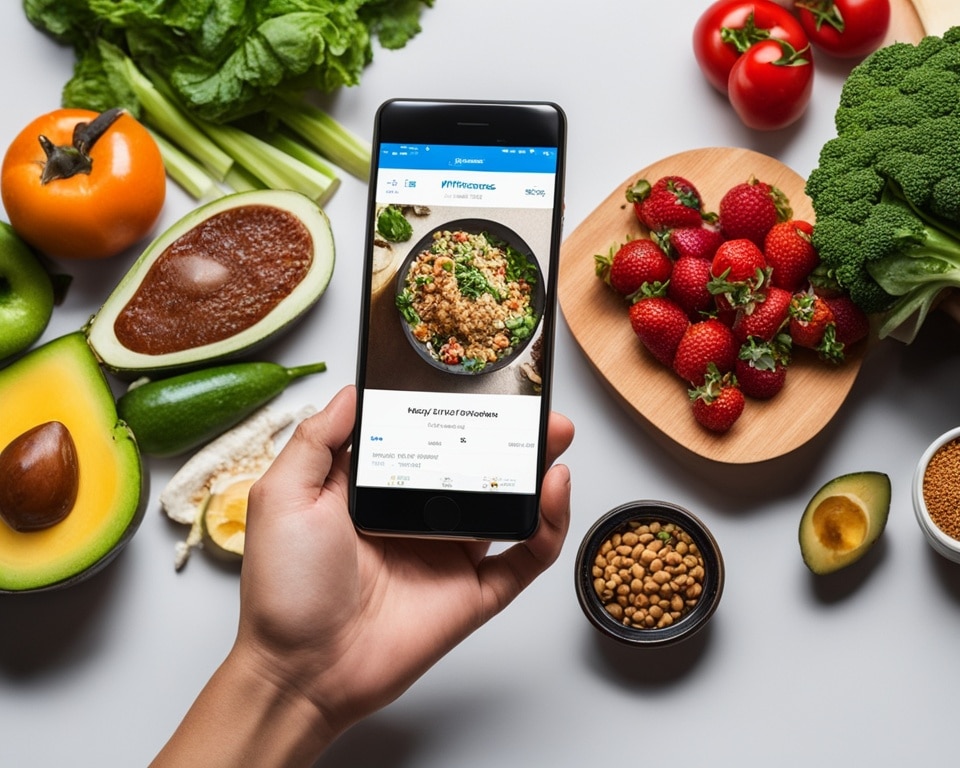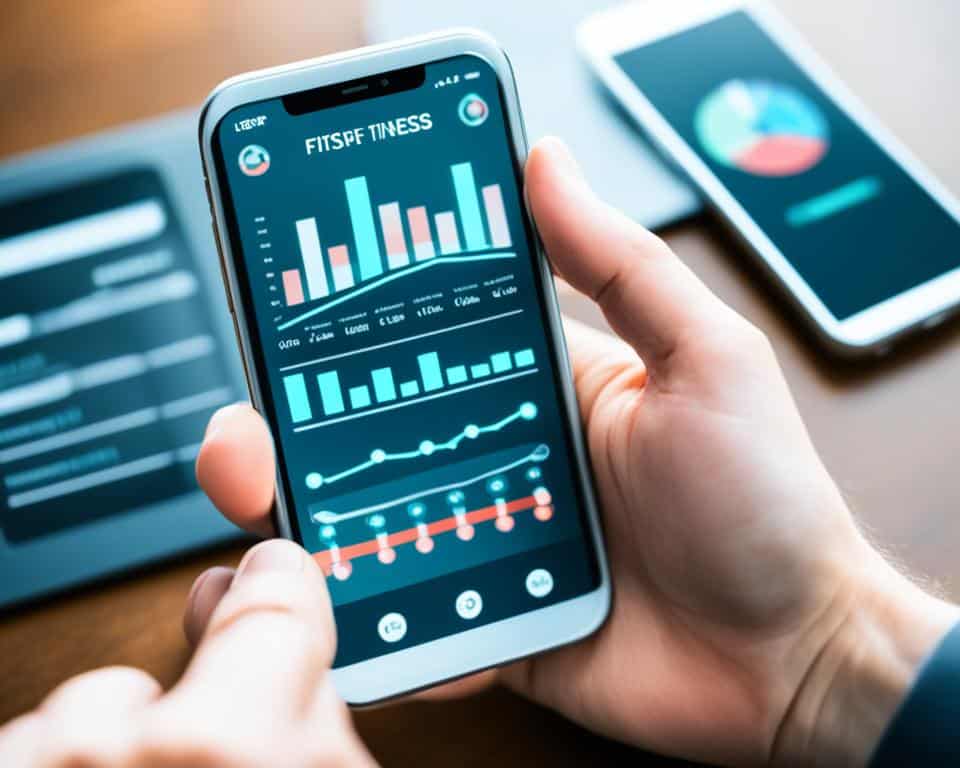In today’s fast-changing health and fitness tech world, making your own fitness tracking app could be a great business move. By knowing the main features, tech needed, and how to make it, you can create a top-notch app. This guide will show you how to make a calorie counting and exercise tracking app that gives users a personal fitness journey. It covers all you need to know to build your own app, like a calorie counting app clone and a MyFitnessPal alternative.
Table of Contents
Key Takeaways
- Understand the core functionality and key features of a MyFitnessPal clone app
- Explore the benefits of creating your own fitness tracking and calorie counting application
- Identify the right technology stack and development best practices for building a MyFitnessPal clone
- Learn how to design an intuitive user interface and integrate a comprehensive food database
- Discover strategies for implementing calorie tracking, exercise tracking, and social sharing features
What is a MyFitnessPal Clone App?
A MyFitnessPal clone app is a mobile app that copies the main parts of the popular MyFitnessPal fitness tracking and calorie counting app. It has features like tracking calories, logging exercises, monitoring progress, and sharing with others. The goal is to pick the key features that made MyFitnessPal a hit and tailor them for your audience.
Understanding the Functionality
A MyFitnessPal clone app is all about helping users keep track of their fitness tracking app functionality and calorie counting app development. Users can log what they eat, see how many calories they burn exercising, and watch their progress towards health goals.
Key Features to Include
When making a MyFitnessPal clone app, you should add these MyFitnessPal app clone features:
- Comprehensive food database for calorie tracking
- Ability to log and track daily calorie intake and macronutrient consumption
- Exercise logging with corresponding calorie burn calculations
- Progress monitoring, including weight, measurements, and goal tracking
- Personalized goal-setting and meal planning tools
- Social features for connecting with friends, sharing progress, and participating in challenges
By focusing on these key features, you can make a MyFitnessPal clone app that gives a similar experience. It will meet the needs of people who want a full fitness and nutrition tracking solution.

Benefits of Creating a MyFitnessPal Clone
Creating a MyFitnessPal clone app brings many benefits for users and app makers. It lets you offer a personalized fitness tracking experience. You can also make money with different monetization strategies.
One big plus of making a fitness tracking app is getting a loyal user base. With a rich and easy-to-use app, you can be a strong choice for users. This is great for those wanting a more personal experience.
Building a calorie counting mobile app also means you can use the growing interest in health and wellness apps. More people are focusing on their health, so they need good fitness tracking tools. A detailed app can enter a big and growing market.
| Advantages of Building a MyFitnessPal Clone App | Benefits of Developing a Fitness Tracking App | Reasons to Create a Calorie Counting Mobile App |
|---|---|---|
| – Attract a loyal user base – Position your app as a viable alternative to the market leader – Offer a personalized fitness tracking experience |
– Tap into the growing health and wellness app market – Provide users with a comprehensive fitness tracking solution – Generate revenue through various monetization strategies |
– Cater to the increasing demand for health and wellness-focused apps – Offer users a detailed calorie counting and nutritional tracking tool – Differentiate your app from the competition and stand out in the market |
With a detailed and easy-to-use MyFitnessPal clone app, you can enjoy many benefits. This can help your app succeed in the competitive health and fitness app market.

“Building a successful fitness tracking app requires a deep understanding of user needs and a commitment to continuous improvement.”
Choosing the Right Tech Stack
Creating a successful MyFitnessPal clone app means picking the right tech stack. The front-end should focus on making the app easy to use and fast. It should meet the needs of health-focused users. The back-end needs to manage data, connect with other APIs, and keep user info safe. By picking the best front-end and back-end tech, you can make an app that works well and grows with your users.
Front-end Technologies
The front-end of your app should make users happy and engaged. For calorie counting apps, some top front-end tech choices are:
- React.js: A JavaScript library for building user interfaces, known for its efficient rendering and component-based architecture.
- Angular: A comprehensive front-end framework that offers a structured approach to building web applications, with features like data binding and dependency injection.
- Vue.js: A progressive JavaScript framework that emphasizes simplicity and flexibility, making it a popular choice for building responsive and dynamic user interfaces.
Back-end Technologies
The back-end of your app handles the app’s core functions and data. For the tech requirements for MyFitnessPal clone app, some top back-end tech choices are:
- Node.js: A JavaScript runtime environment that allows developers to build scalable network applications using an event-driven, non-blocking I/O model.
- Ruby on Rails: A popular web application framework written in Ruby, known for its emphasis on simplicity, productivity, and Convention over Configuration (CoC).
- Django: A high-level Python web framework that encourages rapid development and clean, pragmatic design, making it a suitable choice for building secure and scalable apps.
Choosing the right front-end and back-end technologies for calorie counting apps ensures your MyFitnessPal clone app meets tech needs and offers a smooth user experience.

Designing an Intuitive User Interface
Making a user-friendly interface is key for a successful MyFitnessPal clone app. Using user interface design for fitness tracking apps and UX best practices for calorie counting mobile apps helps. This way, you make an app that is easy to use and keeps users interested.
UI/UX Best Practices
For a top-notch MyFitnessPal clone app UI/UX, follow these tips:
- Make sure the app is easy to navigate, so users can find important features fast.
- Use clear data visualization to show fitness and calorie info in a simple way.
- Make sure the app flows smoothly, helping users move through its features easily.
- Add personalization options so users can tailor their experience to their goals and likes.
- Use responsive design to make sure the app looks good on all devices.
Following these user interface design for fitness tracking apps and UX best practices for calorie counting mobile apps helps make a MyFitnessPal clone app that looks good and works well.
“Designing an intuitive and user-friendly interface is essential for the success of your MyFitnessPal clone app.”
Integrating a Food Database
Creating a strong MyFitnessPal clone app means having a big food database. This database lets users log their calories correctly. You can use a third-party API or make your own database for this.
Having a food database is key for food database integration for calorie counting apps. It gives users lots of food options with nutrition facts. This makes logging calories easy and right for your nutrition data sources for fitness tracking apps.
Leveraging Established Food Data Sources
Using well-known data sources is a smart way to add a food database. Look at the USDA Food Composition Database or other trusted nutrition APIs. They have lots of food info, like calories, nutrients, and more.
| Data Source | Advantages | Considerations |
|---|---|---|
| USDA Food Composition Database |
|
|
| FoodData Central API |
|
|
Using well-known data sources saves time and effort. It makes sure your MyFitnessPal clone app food logging features are accurate and reliable. This lets you work on other important parts of your app.
“Integrating a comprehensive food database is crucial for providing users with an accurate and seamless calorie tracking experience in your MyFitnessPal clone app.”
Implementing Calorie Tracking
A MyFitnessPal clone app is all about tracking calories. It lets users log their food and figure out their daily calorie needs. These needs depend on their age, gender, weight, and how active they are. With personalized calorie goals and easy logging tools, users can reach their fitness goals better.
Calculating Daily Calorie Needs
Knowing how many calories a user needs is crucial for a calorie tracking app. It uses formulas like the Mifflin-St Jeor equation. This equation looks at age, gender, weight, and activity level to estimate basal metabolic rate (BMR) and total daily energy expenditure (TDEE). Users get their own calorie targets, helping them plan their diet and exercise.
| Factor | Calculation |
|---|---|
| BMR (Basal Metabolic Rate) | 10 x weight (kg) + 6.25 x height (cm) – 5 x age (years) + 5 (for men) or – 161 (for women) |
| TDEE (Total Daily Energy Expenditure) | BMR x Activity Factor (1.2 for sedentary, 1.375 for lightly active, 1.55 for moderately active, 1.725 for very active, 1.9 for extremely active) |
Your MyFitnessPal clone app can give users accurate daily calorie targets. This helps them track their progress and make smart choices about food and exercise.
The app should also have easy calorie logging features. This includes a big food database, barcode scanning, and saving favorite meals or recipes. These make it simple for users to log their food all day.
With these calorie tracking features, your MyFitnessPal clone app becomes a key tool for fitness journeys. It helps users keep track of their progress and reach their health and wellness goals.
Adding Exercise Tracking Functionality
To make a top-notch MyFitnessPal clone app, it’s key to add strong exercise tracking features. These let users log their workouts, track their progress, and see how their exercises affect their calorie balance.
Here are the main exercise tracking features to add:
- Workout logging: Let users record their exercise details, like the type, how long it lasted, and how hard it was.
- Progress tracking: Show users their workout history in a way that lets them see trends and how much they’ve improved.
- Calorie burn estimation: Link the app’s calorie counting with exercise info to help users understand their energy use and workout effects.
By combining exercise tracking with calorie counting, your app offers a full fitness management tool. It helps users reach their health and wellness goals better.
| Feature | Description |
|---|---|
| Workout Logging | Let users record details about their exercise sessions, such as the type of activity, duration, and intensity. |
| Progress Tracking | Provide users with visual representations of their workout history, allowing them to analyze trends and measure their improvements over time. |
| Calorie Burn Estimation | Integrate the app’s calorie counting capabilities with exercise data to give users a comprehensive understanding of their energy balance and the impact of their workouts. |
By linking exercise tracking with calorie counting, your app gives a full fitness management tool. It helps users meet their health and wellness goals better.
Social Sharing and Community Features
Building a community in your MyFitnessPal clone app can set it apart. Adding features for sharing progress, connecting with friends, and joining challenges can make users loyal and engaged. This can lead to a strong user base and more people sticking with the app.
When designing social features for fitness apps and community engagement tools for MyFitnessPal clone apps, focus on making the experience better. These tools can make users compete healthily and motivate each other. By allowing user sharing and collaboration in calorie counting apps, you can build a lively, supportive community. This keeps users coming back.
Fostering Engagement Through Social Features
Here are some key social and community-focused features to think about for your app:
- Newsfeed or activity feed where users can share their progress, milestones, and workout routines
- Ability to connect with friends, family, and like-minded individuals to create a support network
- Group challenges, competitions, and leaderboards to encourage friendly rivalry and motivation
- Discussion forums and chat functionality to facilitate discussions and sharing of tips and advice
- Ability to comment on and “like” other users’ posts to foster a sense of community
By adding these social features for fitness apps and community engagement tools for MyFitnessPal clone apps, you make a platform that helps users reach their health goals. It also keeps them engaged and connected with the app and its community.
“Building a strong community is essential for the long-term success of a MyFitnessPal clone app. Users who feel connected and supported are more likely to stick with the app and achieve their goals.”
| Feature | Benefit |
|---|---|
| Newsfeed and Activity Feed | Enables users to share their progress and stay motivated by seeing the achievements of others |
| Friend Connections | Allows users to build a support network and hold each other accountable |
| Group Challenges | Fosters a sense of community and friendly competition, driving user engagement and retention |
| Discussion Forums | Facilitates the exchange of tips, advice, and experiences, creating a valuable resource for users |
MyFitnessPal Clone App Development
Creating a MyFitnessPal clone app is a thrilling project with several steps. You’ll plan the app’s features, use APIs, and set up databases. It’s all about paying attention to details and planning well. Let’s look at the main stages to make your own app for tracking calories and fitness.
The first step is to plan the app’s main features. Think about calorie tracking, logging exercises, and sharing on social media. This helps you make a clear plan for a smooth user experience.
Then, focus on designing a user-friendly interface. Use UI/UX design best practices to make the app look good and easy to use. This makes users want to stick with your app.
Building the app means working on both the front-end and back-end. The front-end, using tech like React or Flutter, deals with how the app looks and works. The back-end, built with Node.js or Python, takes care of storing data, connecting with APIs, and handling server tasks.
Adding a big food database is key for a MyFitnessPal clone app. It lets users easily find and log what they eat. This makes tracking calories and watching diets easier.
Testing the app is very important. It checks if the app works well, is stable, and easy to use. You’ll do unit testing, integration testing, and end-to-end testing to make sure everything works right.
With a clear plan and the right tech, you can make your MyFitnessPal clone app a reality. It will give users a full fitness tracking tool.
Testing and Deployment Strategies
Creating a fitness app like MyFitnessPal needs a strong testing plan and a smart deployment process. This ensures a smooth experience for users. When making your own calorie counting app, focus on testing methods for fitness apps and deployment strategies for MyFitnessPal clone apps. This keeps your app’s quality high.
Comprehensive Unit Testing
Start by doing unit tests to check each part of your app works right. This means checking how user input is handled, making sure calorie counts are right, and checking the food database works well. Testing each part alone helps find and fix problems early.
Thorough Integration Testing
Then, move on to integration testing. This checks how all parts of your app work together smoothly. Make sure the user interface, calorie tracking, and sharing features work well together. This makes sure your app is easy and fun to use.
| Testing Approach | Objectives | Key Considerations |
|---|---|---|
| Unit Testing |
|
|
| Integration Testing |
|
|
Using a detailed testing plan with unit and integration tests makes sure your MyFitnessPal clone app is reliable and high quality. This helps fix any problems before you release it.
Monetization Strategies
Starting your own MyFitnessPal clone app means thinking about how to make money and keep your business going. There are many ways to make money from monetization options for fitness apps, each with its own benefits and things to consider.
In-App Purchases: Unlocking Premium Features
One way is through in-app purchases. These let users buy premium features or special content. This could be better meal planning tools, custom workout plans, or advice from fitness pros. By offering these extras, you can make money and help users improve their health.
Subscription Models: Cultivating Loyal Users
Another good way is with a subscription-based vs. in-app purchase models. Subscriptions give users lots of features like meal plans, activity tracking, and support from a community. This makes users stick with your app for the long haul.
| Monetization Model | Advantages | Disadvantages |
|---|---|---|
| In-App Purchases |
|
|
| Subscription Models |
|
|
The choice of monetization options for fitness apps and revenue generation for MyFitnessPal clone apps depends on your audience, app features, and business goals. By looking at subscription-based vs. in-app purchase models, you can find a way to make money that fits your users’ needs.
Marketing Your MyFitnessPal Clone App
Marketing is key to your app’s success. You need a full marketing plan with tactics like app store optimization, content marketing, social media, and influencer partnerships. This will help draw in and keep users.
One top strategy is app store optimization (ASO). Make your app’s title, description, keywords, and visuals stand out. This boosts its visibility and chances of being found by potential users. Keep an eye on your ASO and update it to stay competitive.
Content marketing is also vital. Share helpful content about health, fitness, and wellness to show your app’s value. Use blog posts, videos, infographics, and social media to highlight what makes your app special.
Being active on social media is crucial too. Use platforms like Facebook, Instagram, and Twitter to talk to your users, answer their questions, and share interesting content. This can increase downloads and keep users coming back.
Working with influencers in health and fitness can expand your reach and boost your app’s credibility. Partner with well-known fitness experts or nutritionists to reach more people and promote your app through their trusted networks.
Using a mix of marketing strategies can help you reach your audience, increase brand awareness, and keep users coming back. With the right plan, your MyFitnessPal clone app can become a go-to tool for managing health and fitness.
Conclusion
Creating your own MyFitnessPal clone app can be both rewarding and profitable. It’s a great move in the booming health and fitness tech market. By focusing on key features, using the right tech, and making the app easy to use, you can stand out.
With careful planning and execution, your app can be a big hit in the health and wellness app world. Key points for success include putting users first, using data to improve the app, and building a strong community. This summary shows the chances and challenges in this exciting field.
Your app’s success hinges on offering a smooth and engaging experience. A strong marketing plan that speaks to your audience is also crucial. By keeping up with trends and what users want, your app can become a go-to for health and wellness.










